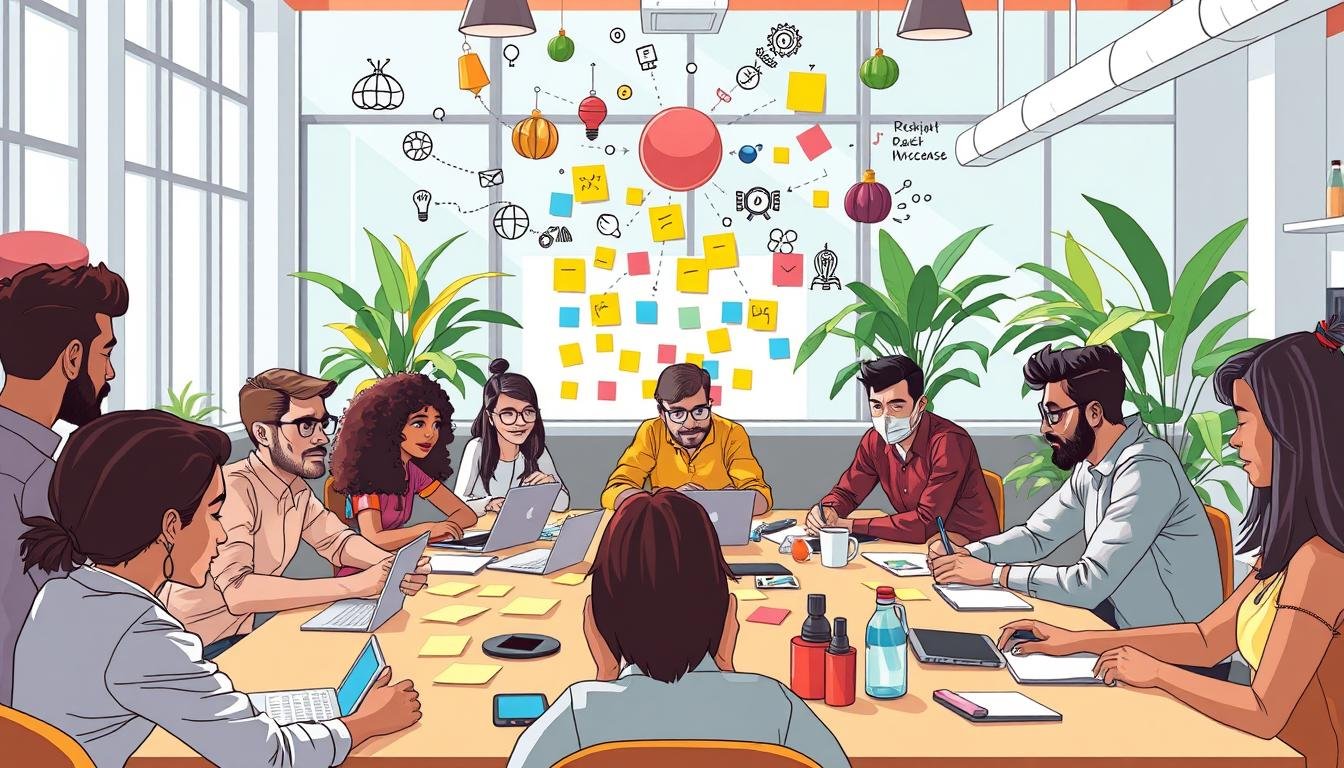Facilitating Innovation Workshops
“Innovation distinguishes between a leader and a follower.” – Steve Jobs
In today’s fast world, innovation is key to leading. Facilitating innovation workshops is vital for leaders to move their organizations forward. These workshops help create new ideas and solve tough problems.
The Innovation Facilitator Design Thinking Train the Trainer program offers over 20 hours of online training. It teaches directors, consultants, and managers to spark creativity. The course includes two one-on-one coaching sessions to help apply new skills.
Darin Eich, a top facilitator coach, has worked with big names like P&G. His workshops have seen a 90% success rate in ideas and a 95% approval from senior teams. People from Apple, Cisco, and Google say these sessions are the best they’ve ever had.
These workshops are more than just talks. They involve interactive activities that spark new ideas. Real teams have come up with innovative concepts that got funding and projects for the next year. This shows the real value of these sessions.
Key Takeaways
- Innovation workshops are essential for organizational growth and problem-solving
- Structured approaches lead to higher success rates in idea generation
- Interactive activities engage participants more effectively than traditional presentations
- Workshops can result in funded projects and real business solutions
- Proper facilitation skills are crucial for maximizing workshop outcomes
Understanding the Fundamentals of Innovation Workshops
Innovation workshops are key in driving teamwork and new ideas in companies. They bring together different teams to solve big problems and find creative answers.
What is an Innovation Workshop
An innovation workshop is a special meeting to boost creativity and solve problems. It’s a place where teams can explore new ideas, question old ways, and come up with fresh solutions. These workshops use Design Thinking to help teams go through the innovation process.
The Role of Design Thinking in Innovation
Design Thinking focuses on people and solving problems creatively. It involves empathy, coming up with ideas, and making quick prototypes. In workshops, Design Thinking helps teams:
- Get to know what users need
- Clearly define problems
- Think of many different ideas
- Make and test prototypes fast
- Keep improving solutions
Core Elements of Successful Workshops
Good innovation workshops have a few important things:
| Element | Description |
|---|---|
| Clear Objectives | Well-defined goals and expected outcomes |
| Diverse Participants | Cross-functional teams with varied perspectives |
| Structured Activities | Engaging exercises like brainstorming and prototyping |
| Supportive Environment | Safe space for risk-taking and idea sharing |
| Skilled Facilitation | Experienced leaders guiding the process |
By using these elements, companies can hold powerful innovation workshops. These workshops can lead to real change and help build a culture of ongoing improvement.
Facilitating Innovation Workshops: Essential Skills and Techniques
Effective Brainstorming Facilitation is key to successful innovation workshops. A skilled facilitator leads the group through structured problem-solving. This creates a space where everyone’s ideas are valued.
Innovation Facilitator Training teaches important skills like being organized, empathetic, and clear in communication. These skills help facilitators set clear goals and explain how to achieve them. Research shows that well-run workshops can increase idea retention by up to 90% when people are involved.
Some important techniques for good facilitation include:
- Reverse polls
- Think-pair-share
- Around-the-horn discussions
- Brainrain brainstorming
These methods help everyone learn in their own way. Adding props, nametags, and activities that make you think helps keep people engaged and learning.
“Diversity of perspectives, backgrounds, skills, and experiences can enrich the quality and quantity of ideas generated by the group.”
Facilitators need to make a safe space where everyone can share their thoughts. This safe space, along with hands-on activities like making prototypes, encourages creativity and taking smart risks. By learning these skills, facilitators can make innovation workshops powerful tools for growth and change.
Creating the Perfect Workshop Environment
The right environment is key to a successful Innovation Workshop. A well-designed space fosters Collaborative Innovation and sparks creativity. Let’s explore the essentials for crafting an ideal workshop setting.
Physical Space Requirements
For in-person workshops, comfort is crucial. Choose a room with ample space, good lighting, and flexible seating. Wall space for sticky notes and whiteboards is a must. For virtual sessions, select a platform that allows easy collaboration and idea sharing.
Tools and Materials Needed
Stock up on essential supplies:
- Whiteboards and markers
- Sticky notes in various colors
- Large sheets of paper
- Pens and notebooks
For remote workshops, use digital tools like Miro or Mural to recreate the collaborative experience online.
Setting the Right Atmosphere
Create an environment where creativity thrives. Play soft background music to set the mood. Arrange refreshments to keep energy levels up. Encourage open communication and remind participants that all ideas are welcome. This approach nurtures a positive atmosphere, crucial for a productive Innovation Workshop.
“Innovation distinguishes between a leader and a follower.” – Steve Jobs
By focusing on these elements, you’ll create a workshop space that inspires creativity and drives Collaborative Innovation. Remember, the environment you create sets the stage for breakthrough ideas and solutions.
Developing a Structured Innovation Process
A well-structured innovation process is crucial for success. It helps teams go through ideation, problem-solving, and implementation. Let’s look at the key parts of a good innovation strategy.
Pre-workshop Planning
Before starting, set clear goals and gather what you need. Make an agenda that matches your innovation targets. Choose a team with different views to add variety.
Workshop Execution Framework
At the workshop, use design thinking. Begin with empathy to understand what users need. Then, define problems, come up with ideas, and make quick prototypes. Keep the conversation open and creative.
Post-workshop Follow-up
After the workshop, make ideas better and plan actions. Keep an eye on how things are going and check if you’re meeting your goals. Use feedback to make your process even better.
| Phase | Key Activities | Outcomes |
|---|---|---|
| Pre-workshop | Define objectives, Create agenda, Select participants | Clear goals, Diverse team |
| Workshop | Empathize, Define, Ideate, Prototype | Innovative solutions |
| Post-workshop | Refine ideas, Develop action plans, Track progress | Implementable strategies |
By sticking to this structured method, you can boost your innovation strategy. Success comes from mixing creativity with discipline in the innovation process.
Collaboration and Team Dynamics in Innovation Sessions
Collaborative innovation is key to success in today’s fast business world. Teams that work well together often do better than solo efforts. This teamwork leads to better problem-solving and quicker solutions to tough challenges.
Good collaboration in innovation sessions needs diverse views. When teams share unique ideas, creative problem-solving grows. It’s important to build a culture of trust and safety where everyone feels free to share.
Virtual tools are vital for innovation management, especially with more remote work. Platforms for managing projects help track progress and tasks. Apps for messaging and sharing files keep teams connected, no matter where they are.
Brainstorming sessions are key for team innovation. They let teams share ideas freely, encouraging creativity and risk. Seeing failure as a chance to learn also boosts this innovative spirit.
| Collaboration Benefits | Percentage |
|---|---|
| Employees valuing teamwork | 75% |
| Organizations investing in collaborative workspace | 60% |
| Employees feeling higher engagement when collaborating | 85% |
To get the most from collaborative innovation, companies should invest in training. Workshops and team-building activities can help teams work better together. This breaks down barriers and makes sharing knowledge easier.
Innovation Workshop Activities and Exercises
Innovation workshops are all about fun activities that spark creativity and solve problems. Let’s look at some great ways to make your next workshop a hit.
Ideation Techniques
Ideation techniques are crucial for creative workshops. The “30 circles” exercise is a fun challenge. It asks participants to fill 30 circles with unique objects in just 7 minutes. This activity helps stretch your creative muscles and think outside the box.
Another cool method is “Squiggle birds.” It’s a 5-minute warm-up that boosts confidence. It prepares you for more challenging tasks ahead.
Problem-Solving Methods
Creative problem solving is essential for innovation. The “Five Whys” technique helps find the root cause of problems. By asking “why” five times, you can uncover deeper issues.
SCAMPER (Substitute, Combine, Adapt, Modify, Put to another use, Eliminate, Reverse) is another great tool. It encourages teams to look at things from different angles.
Creative Thinking Tools
To boost creativity, try the “Alternate Uses” exercise. Teams have 3 minutes to list as many uses as possible for a common object. This activity pushes the limits of your thinking.
The “Impossible Objects” activity, inspired by Michael Michalko’s Thinkertoys, is another quick challenge. It tests your imagination in just 5 minutes.
| Exercise | Duration | Purpose |
|---|---|---|
| 30 Circles | 7 minutes | Stretch creative muscles |
| Squiggle Birds | 5 minutes | Boost confidence |
| Alternate Uses | 3 minutes | Encourage divergent thinking |
| Impossible Objects | 5 minutes | Test imagination |
By adding these activities to your workshops, you’ll create a dynamic space for new ideas and solutions.
Measuring Workshop Success and Impact
Measuring the success of innovation workshops is key to good innovation management. It helps make future sessions better and shows value to those who matter. Let’s look at what’s important for evaluating workshops.
Key Performance Indicators
To see how well a workshop did, use specific metrics. Look at the number and quality of ideas, how engaged participants were, and how many ideas got implemented. These KPIs help understand the workshop’s short and long-term effects on innovation.
Feedback Collection Methods
Get feedback from participants to improve your innovation strategy. Use surveys, interviews, or focus groups to get their thoughts. Online tools like Google Forms or SurveyMonkey make it easy to get quick feedback. For a deeper look, do follow-up interviews a few weeks later to see the lasting effects.
Implementation Tracking
Keep an eye on idea progress from start to finish. This part of innovation management tracks idea movement, development stages, and their effect on goals. Use a simple tracking system or a project management tool to see how ideas are doing and measure success over time.
| Metric | Description | Measurement Tool |
|---|---|---|
| Idea Quality | Check the viability and potential impact of ideas | Expert panel evaluation |
| Participant Engagement | Measure how active and enthusiastic participants were | Observation and feedback forms |
| Implementation Rate | Track how many ideas move to development or launch | Project management software |
By regularly measuring workshop success and impact, you can make your innovation strategy better. This leads to ongoing improvement in your innovation management.
Conclusion
Running innovation workshops is a dynamic process that boosts creativity and finds new solutions. Over a decade, nearly 50 workshops were held in four countries. This shows that planning and execution are key to success.
The best group size is 5-7 people. This size helps everyone interact and stay productive during brainstorming sessions.
Creating the right setting is essential for innovation. Choose the right place, build trust with participants, and make sure they feel safe sharing ideas. Workshops usually have 10-25 people and last 30 minutes for idea sharing.
It’s important to have a clear voting system. This should focus on how ideas benefit the business and how easy they are to put into action.
Measuring workshop success is crucial for getting better. Look at how well the sessions go, how the facilitators do, and the business results. Training facilitators regularly keeps the quality high.
By focusing on these points, companies can grow and change in a fast-paced world. Innovation workshops are key tools for this growth and change.
Source Links
- Innovation Facilitators & Innovative Facilitation Training
- Innovation Workshops: Brainstorming Facilitation Training
- The 6 Phases of Innovation Workshops – Fresh Consulting
- Facilitating Product Innovation :: UXmatters
- The Best Approaches to Successful Innovation Workshops
- How to cultivate workshop culture for better innovation
- What are the best ways to encourage innovative thinking in your facilitation participants?
- Facilitation Training Online Workshops
- How to facilitate a successful workshop in 18 simple steps
- 7 tips for organising an innovation workshop with your team – Beeliners English
- The Best Innovation Process – Definition, Steps and Examples
- Innovative Team Collaboration: Igniting Creativity for Extraordinary Results
- 13 Steps to Establishing an Effective Collaboration and Innovation Hub
- Igniting Innovation through Team Collaboration
- 9 Best Exercises to Spark Creativity in Ideation – Innovation Lab
- SEI | Insights | 8 Powerful Design Thinking Exercises
- DRAFT_Innovation_Workshop_CribSheet
- Ten simple rules for measuring the impact of workshops
- What are the best tools to measure workshop outcomes and impact?
- Inspiring Innovation: Best Practices for Facilitating a Successful Ideation Session
- 10 steps to a successful innovation workshop
- Enhancing Innovation Through Learning-Centric Workshop Design








